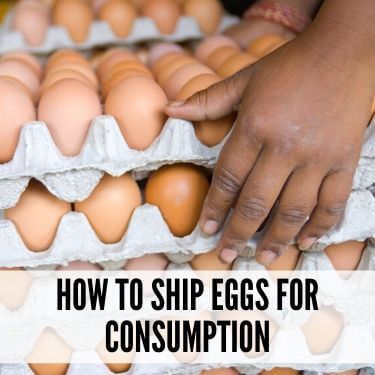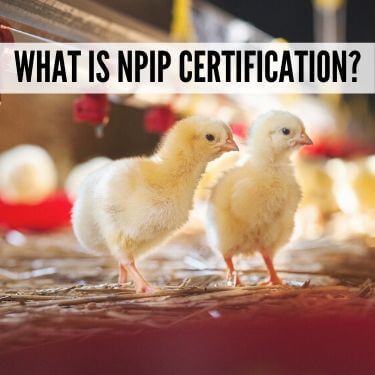What's the best way to ship eggs? If you’re planning to ship eggs in the near future or are curious about the process, there are important details you need to know. Whether it’s shipping hatching eggs or eggs for consumption, you need to follow some recommended steps to ensure the safety of your eggs. The types of packaging materials you use and the temperature that the eggs are shipped at are just a couple of the need to know details.
When shipping eggs for consumption, the USDA recommends shipping them in fiberboard boxes with a temperature between 40°F and 45°F. Hatching eggs are shipped at slightly higher temperatures between 55°F and 65°F. Since eggs for consumption are odor absorbing, shippers need to be mindful about other produce being shipped along with eggs. If you’re receiving eggs, it’s a good idea to work with an NPIP certified farm or hatchery.
Our comprehensive guide below provides you with everything you need to know about shipping eggs.
Given how fragile hatching eggs are, it’s important to take every safety precaution and measure that you can to protect them while they’re in transit.
Packing eggs is about more than just fitting them in egg cartons and surrounding them with packing peanuts. Packing your eggs for shipping is an involved task that requires several layers of protection such as shredded paper or bubble wrap in order to absorb vibrations and shocks and protect your eggs. It’s important to establish a thorough packaging process, wrapping each egg individually and making sure they’re protected before placing them in a specially-designed egg carton that surrounds packaging material.
Here are some of the steps that you should take when packaging and shipping eggs.
This should give you a rough idea of what a thorough packing process looks like. It’s an involved and rather long process, but it will protect the hatching eggs in transit and ensure they arrive safely at their destination.
Are you looking to ship other farm-fresh commodities? Learn How to Ship Cheese, get the ins and outs about Soybean Transportation and more on our resources page.

Hatching eggs are incredibly fragile, meaning that a gentle method of transportation is usually preferred to keep them safe. However, with the right packaging material and protection for each egg, it’s possible to transport them using any common vehicle such as a plane or a large truck. If they are protected, then the impact of the vibrations and movement of the vehicle won’t affect the eggs, meaning there will be no cracks or damage to be concerned about.
However, shipping your eggs with these methods can be daunting especially if you’re worried about the potential of damaging those hatching eggs. If you’re planning on partnering with a shipping service, then it’s essential to speak to a company that understands how to ship fragile items such as eggs. It’s important to specify that your package contains eggs so that it can be handled with extra caution. The right packaging and warning on the boxes will also help ensure that they are handled carefully by everyone in the logistics chain.
If you plan to send hatching eggs in winter then it’s important to learn how you can better take care of your eggs so that they do not suffer from the elements. After all, leaving your package out in the cold or in the back of a truck for a long period of time will ultimately cool down the inside of your package. This could potentially subject your eggs to very low temperatures which will severely impact the hatch rate of your eggs.
In order to avoid this, it’s possible to use the following methods.
Shipping hatching eggs in winter can come with many concerns, but it’s also true for summer where temperatures can get incredibly high and thus could also impact your eggs. Taking the right weather-appropriate measures is vital to ensure that your eggs arrive in one piece at their destination.
Regardless of when you’re shipping eggs, you should rely on a refrigerated truck to ensure optimal temperature throughout the entire journey. Our company provides refrigerated shipping for eggs and any other product that needs a temperature controlled environment.

The majority of this article has so far been about hatching eggs, but what about shipping eggs for consumption? Does it require some kind of change in the way you package and label them, or do you follow the same methodology? In most cases, nothing really needs to change between shipping hatching eggs and shipping eggs for consumption. Eggs are fragile either way and it’s still recommended to use ample packaging materials at the bottom of the box to give them plenty of cushioning. We’d also suggest that you wrap each egg even though they’re not meant for hatching. While this might sound rather time-consuming, it will ensure that your eggs arrive without damage. It will also protect the eggs, insulating them should you decide to ship them during the colder months. In short, you’re generally going to be using the same methods as you would for shipping hatching eggs.
However, if you’re shipping your eggs internationally, we do have to mention that the customs process might be a little different. Labelling might also change to indicate that the eggs are fragile and are considered perishable foods. You’ll also have to go through inspections (as indicated below) before your package can be considered safe to send. A reliable logistics company, like R+L Global Logistics will properly advise you on what’s require when shipping eggs for consumption.
In the U.S. alone, the FDA estimates that there are roughly 79,000 cases of foodborne illness which contributes to around 30 deaths which are caused solely by eggs that are contaminated by Salmonella Enteritidis. As a result, regulations around shipping not just hatching eggs, but eggs for consumption are now far tighter than before. This has made it more difficult for someone to ship eggs for consumption across the country unless the services they use manage to follow the right regulations.
As mentioned above, eggs for consumption are subject to being inspected. This is to ensure that they do not contain any kind of disease before they are released into another part of the country. These inspections may even lead to pasteurization and there are typically some special packaging laws under the USDA’s Egg Products Inspection Act (EPIA). The full list of regulations can be found here on the USDA’s EPIA information page.
If may be difficult to understand if you’re meeting the regulations. When it comes to proper handling during the shipping process, we have you covered. Our company ensures all federal and state regulations are followed providing you with security and peace of mind.

As you can imagine, sending eggs to someone else inside of a box can be quite a daunting prospect. However, for the buyer, it can also be a challenging decision to make seeing that they are the one receiving the product. Nobody wants to receive low quality eggs that will result in poor hatch rate or less than desirable taste. That’s where the NPIP certification comes in handy.
NPIP, short for National Poultry Improvement Plan, is a voluntary certification system that farms and hatcheries can participate in. For a breeder, this is an important certification to obtain in order to make your business more legitimate. If you’re relying on a logistics company, then NPIP certification still applies because they must specialize in the safety and transportation of hatching eggs.
Here are a couple of reasons why the NPIP certification is important as both a buyer and seller.
Even though a shipping company does not breed birds or sell eggs, they can still understand the processes involved thanks to the NPIP certification.
Getting NPIP certified involves a series of examinations to ensure that a facility meets the standards of the NPIP. Hatcheries are required to test their flock for any kind of disease that could be included in the certification such as salmonella or mycoplasma. These testing procedures are unique to each state, but they generally involve submitting a blood test. Depending on the number of birds in a hatchery, a different number of them will be tested. For instance, having under 300 birds means that they will all be tested. In order to maintain an NPIP certification, hatcheries must test their birds every year.
To obtain NPIP certification, the NPIP website lists all state-specific point of contacts that can be reached. The full list can be found here.
New York boasts a surprisingly diverse agricultural history. In fact, many of its biggest exports are rooted in dairy products that account for around $2.56 billion dollars each year. Chicken eggs are actually on the list too at $194 million each year. With the United States providing around 75 billion eggs to the world per year (roughly 10% of the world’s egg supply), it’s no surprise that such a diverse state such as New York is growing in popularity and exporting more of its chicken eggs.
As of 2015, chicken eggs were 5th on a list of the most-produced agricultural products in New York. This puts it above floriculture, hay, soybeans, turkey and snap peas. However, it loses against dairy products ($2.56 billion), cattle and calves ($377 million), corn ($335 million) and apples ($275) million. Still, this is a huge number of eggs that goes to many different sources such as restaurants and supermarkets, but a small portion of them are also hatched.
Given that the egg industry in New York is so big, it takes a dedicated and experienced global logistics service to help you manage such an elaborate operation. If you’re looking to sell and ship eggs to or from New York, then don’t hesitate to get in touch with us for more information.
Like New York, a large portion of Pennsylvania’s agricultural revenue comes from eggs. The annual profit of the chicken egg industry in Pennsylvania is almost half a billion dollars, and the state is responsible for producing more than 7 billion eggs each year! This ranks Pennsylvania as the 3rd largest egg producer in the U.S., and makes the commodity an iconic symbol of Pennsylvania agriculture.
Despite the massive number of eggs being shipped out from Pennsylvania, it also has a diverse agricultural market. It is responsible for producing a large portion of the nation’s broiler chickens, turkeys, soybeans, mushrooms, and beef.
R+L Global Logistics is proud to be one of the leading providers of global logistics services and truckload shipping. We pride ourselves on our years of experience, our dedication to customer service and our attention to detail. We know that shipping hatching eggs can be a challenge which is why we focus on providing our customers with a comprehensive and trustworthy service.
If you’re more interested in shipping eggs for consumption, then we’re also more than happy to provide you with a complete service to get your eggs where they need to. We make sure to follow state-specific regulations and value communication with our clients to ensure that you know what we’re doing at every step of the way. This level of transparency is always appreciated by our most trusted clients and we’re confident that we can help you ship your eggs with minimal effort on your part.
So if you’re looking for the best way to ship eggs, don’t hesitate to get in touch with us today. Give us a call at 866-353-7178 or click “get a quote” below to reach one of our logistics experts.
R+L Global Logistics
315 NE 14th St., Ocala, FL 34470